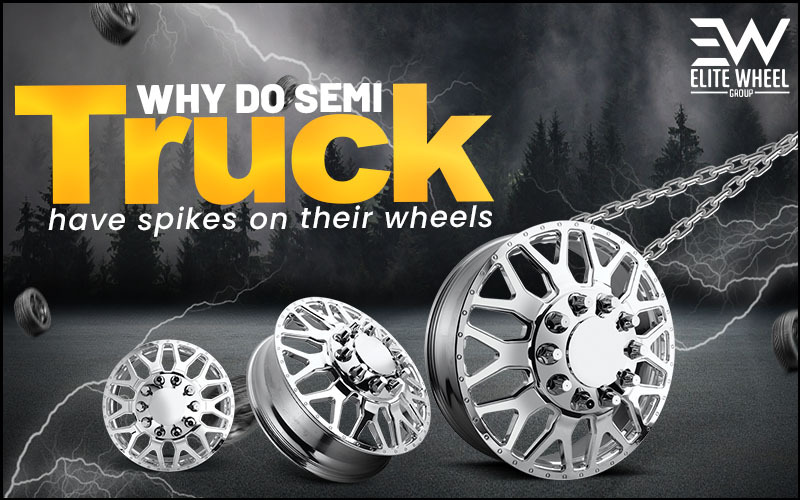Semi trucks, also known as tractor-trailers or big rigs, are an essential part of our transportation industry. You may have noticed that some semi trucks have spikes or studs on their wheels. Have you ever wondered why?
In this blog post, we will delve into the purpose and benefits of these spikes, unraveling the reasons behind their presence. Join us as we explore the world of semi truck wheels and discover the importance of these unique features.
Wheel Spikes
Wheel spikes are fancy accessories that you can put on your car's wheels. They are pointy coverings or longer lug nuts that add a decorative touch. Lug nuts are the bolts that keep your wheels securely attached to the hub of your vehicle. It's important not to mix up wheel spikes with tire studs, which are tiny metal studs inserted into tire treads to improve grip, especially on icy or snowy surfaces.
Enhancing Traction: The Role of Wheel Spikes
One of the primary reasons why semi trucks have spikes on their wheels is to enhance traction. Traction is crucial for vehicles that operate in various weather conditions, especially in regions with snow, ice, or slippery surfaces. The spikes on the wheels of semi trucks are specifically designed to provide additional grip on the road.
Improved Braking Performance
Apart from enhancing traction, the spikes on semi-truck wheels also contribute to improved braking performance. When a semi-truck applies its brakes, the spikes dig into the road surface, allowing for increased friction. This additional friction helps the truck come to a stop more effectively, reducing the braking distance and enhancing overall safety.
Purpose of semi-truck wheel spikes
Despite what your basic instincts might tell you, the spikes on semi-truck wheels are not meant to intimidate or frighten other drivers on the road. Instead, they serve the following purposes:
To keep other drivers from getting too near
Semi-trucks have areas where the driver can't see called blindspots. These blindspots are found all around the truck. When smaller vehicles end up in these blindspots, it can be dangerous because the truck driver can't see them. That's why truckers put spikes on their wheels, to discourage other drivers from getting too close to their trucks. When the spiked wheels are on, it helps keep other drivers at a safe distance, which lowers the chances of accidents happening. This way, everyone can stay safe and happy on the road.
To keep the wheel lug nuts safe from the weather conditions
Truckers use spikes on their wheels to keep the lug nuts safe from the weather. To explain further, when two drivers take turns driving a truck, it can be on the road for almost 24 hours. During that time, at a speed of 60 miles per hour, the truck covers a distance of 1440 miles. This means that the truck encounters different weather and environmental conditions in just one day.
Because of this constant exposure to the elements, the lug nuts on the wheels can start to rust or lose their appearance. That's when the spikes come into play. Their purpose is to safeguard the lug nuts while the truck travels through various weather conditions and environmental situations.
Safe Maneuvering on Mountainous Terrain
Semi-trucks frequently navigate mountainous terrains, where steep inclines and winding roads pose challenges. The spikes on their wheels play a significant role in ensuring safe maneuvering on such terrains. By providing enhanced traction and grip, the spikes enable semi trucks to navigate uphill and downhill slopes more securely, reducing the risk of accidents and improving control over the vehicle.
Preventing Wheel Spin
Wheel spin can be a significant concern, especially when driving on surfaces with low traction. The spikes on semi truck wheels act as a preventive measure against wheel spin. As the spikes dig into the road surface, they create more friction, which reduces the likelihood of the wheels spinning freely. This feature is particularly beneficial in challenging road conditions, such as mud, gravel, or icy surfaces.
Enhanced Stability and Load Distribution
Semi-trucks often carry heavy loads, which can impact their stability and weight distribution. The spikes on the wheels help enhance stability by improving weight distribution. As the spikes penetrate the road surface, they provide additional support and distribute the weight more evenly across the wheels. This feature contributes to better stability and control, especially when carrying large or uneven loads.
Regulatory Compliance and Safety
In certain regions or during specific seasons, regulatory bodies require semi trucks to have spikes on their wheels to comply with safety standards. This mandate ensures that the trucks can operate safely in challenging weather conditions. By adhering to these regulations, semi-truck drivers and fleet operators prioritize the safety of themselves and other road users.
Are truck tire spikes dangerous?
Well, not really. They are unlikely to harm you, but they might scratch your car.
Truck tire spikes are usually made of aluminum alloy, which is not very strong. If a truck with spinning spikes gets close to your vehicle and they touch it, it might leave some scratches on your car door. However, it's highly unlikely for them to cause any significant damage or penetrate your car.
The main purpose of truck tire spikes is to intimidate and catch your attention. They are designed to discourage you from staying in the blind spots of a truck, which are the areas on the sides of the truck and trailer where the driver has limited visibility. If you feel the urge to move away and create more space between your vehicle and the truck, then the spikes are doing their job as intended.
Conclusion
Semi-trucks play a crucial role in transporting goods across vast distances. The spikes on their wheels serve multiple purposes, including enhancing traction, improving braking performance, enabling safe maneuvering on mountainous terrains, preventing wheel spin, enhancing stability and load distribution, and ensuring regulatory compliance.
These features are designed to optimize the truck's performance, improve safety, and enable efficient transportation of goods. The next time you spot a semi-truck with spikes on its wheels, you'll know the reasons behind this unique and functional design choice.
See Also: THE BEST WHEELS FOR LIFTED TRUCKS



